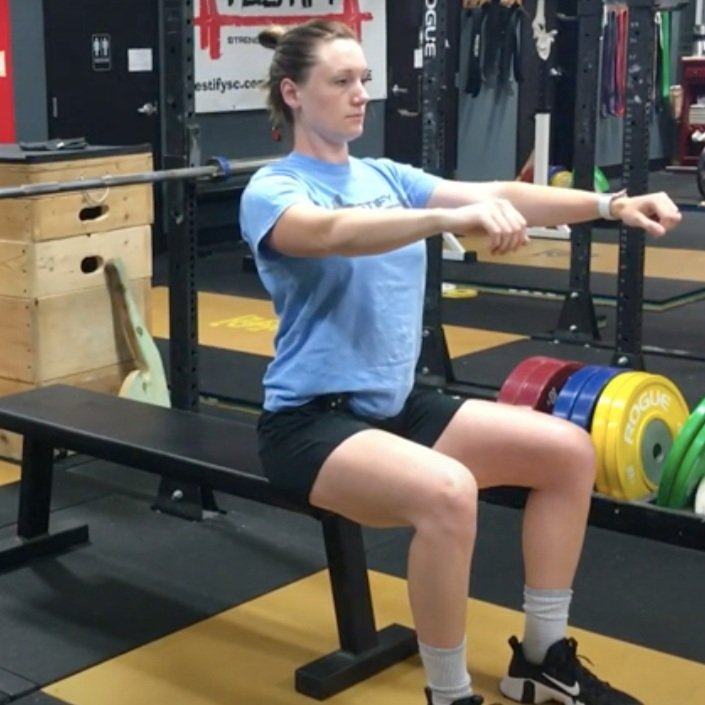The Testify Chronicle - July 8, 2024
/THIS WEEK'S SUBMISSION
From our video 8 Things Successful Lifters Do Before Squatting HEAVY (plus 2 BONUS tips) (click the title to watch):
Max Toulouse
Chalk makes a massive difference in maintaining hand position. Even on highly knurled bars, my hands will begin to move out during a set without chalk.
Phil
Absolutely - nailed it.
TESTIFY ONLINE COACHING
Want to get stronger working remotely with one of our Starting Strength Coaches? Click here to contact us and learn more.
Get Stronger. Live Better. Start today.
ARTICLES & VIDEOS
8 Things Successful Lifters Do Before Squatting HEAVY (plus 2 BONUS tips)
What should you take care of before a heavy squat? We cover 8 simple and effective tips - plus 2 bonus tips - when preparing to squat heavy. Click here to watch.
WRIST WRAPS: The Complete Guide and How NOT to Put Them On! (Lifting Gear Series)
We cover everything you'll ever want to know about wrist wraps, including how NOT to put them on. This is the 4th article in the "Lifting Gear" series. Click here to read.
Blast from the Past: 2 Deadlifting Pieces of Equipment You NEED to Have!
Want a bigger deadlift? Phil covers two pieces of equipment that will immediately strengthen your deadlift. Click here to watch.
Blast from the Past: The Bench Press: You're Forgetting to Do This - Part 4
Are your terrible shoulders ruining your bench press? We quickly discuss the problem as well as how to correct your shoulder positioning. Click here to read.
“GET STRONGER - LIVE BETTER” SHIRTS ARE AVAILABLE!
Why do you train? Because getting stronger makes everything else easier. Get stronger. Live better. “Testify” to this message and represent your favorite gym with this shirt in several color options.
Click here to head to the Testify Store.
WHAT'S COMING UP
Reminder: On the afternoon of Friday, 07/12/24, our training hours will run from 4:00 p.m. - 5:30 p.m. as we are hosting the annual IronFest competition that day. The morning hours remain the same as usual.
Below are a few of our upcoming events, and you can find out what else is on the calendar by heading to our events page at www.testifysc.com/events.
Testify IronFest VI
July 12, 2024
IronFest is a team-based strength meet wherein the contested lifts will be the squat, press, bench press, and deadlift. Competitors will form teams of 2 lifters/team and perform all 4 lifts; each lifter will perform one upper body lift and one lower body lift, and each lifter will receive 3 attempts for each lift.
Click here to register or for more information.
Minneapolis, MN: Starting Strength Squat & Deadlift Camp
August 31, 2024
Spend the day learning the theory and practice of the low bar back squat and the deadlift.
Participants will spend lots of time on the platform receiving coaching and instruction on the squat and deadlift in a small group setting. We will also have a lecture and discussion on programming and cover how to identify and correct common technical problems.
Click here to register or for more information.
Starting Strength Self-Sufficient Lifter Camp
September 28, 2024
Spend the day learning the Squat, Press, and Deadlift and how to self-evaluate your lifts while training in your garage or commercial gym without a coach.
Click here to register or for more information.
THIS WEEK’S CONDITIONING
Option 1
Sled
Outdoors:
10 rounds of:
Push sled 100 ft
Pull sled 100 ft (hand over hand)
Indoors:
20 rounds of:
Push sled 50 ft
Pull sled 50 ft (hand over hand)
Compare to 2024.05.06.
Option 2
Bike/Row for 9 rounds:
1 min on
1 min off
Record distance for each round.
Compare to 2024.04.15.
Option 3
1. 5 x 50 ft seated sled pull. Add weight each round. Rest as needed.
2. 5 x 100 ft duck walk. Add weight each round. Rest as needed.
Compare to 2024.03.18.
Option 4
Outdoors
4 rounds:
50 yd farmer carry
80 m sled drag
Rest 2 min
Indoors
4 rounds:
100 ft farmer carry
100 ft sled drag
Rest 2 min
Compare to 2024.03.18.
As always, we hope this helps you get stronger and live better!



















